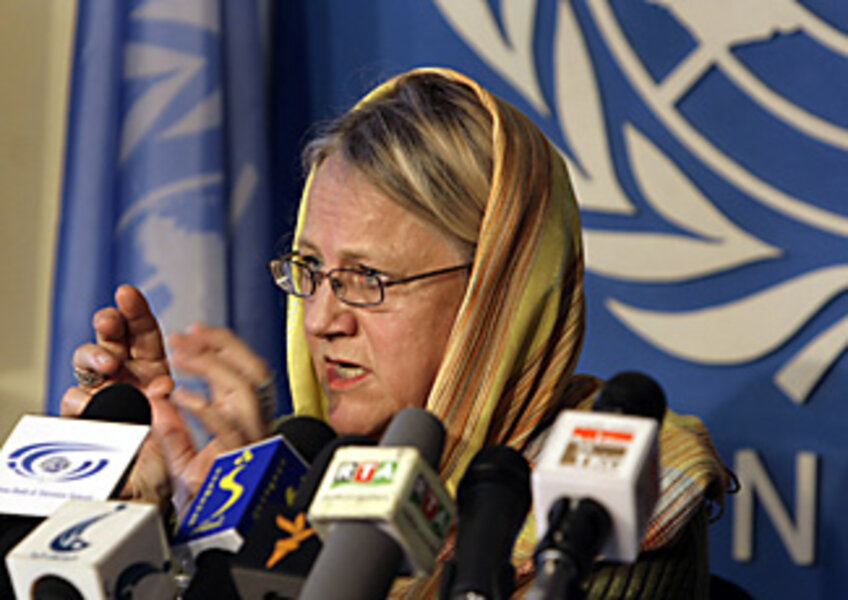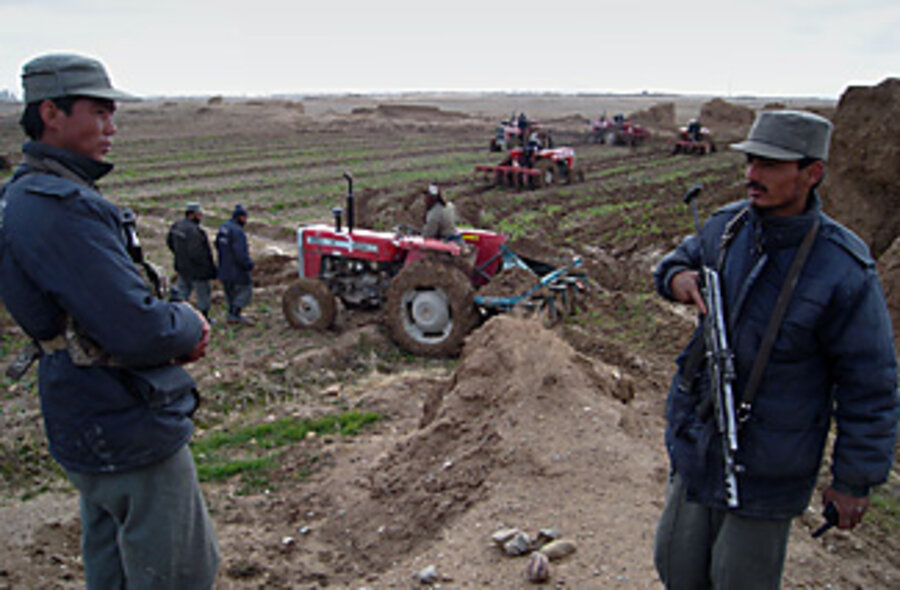Afghanistan's soaring drug trade hits home
| KABUL, AFghANISTAN
Muhammad Nasir lives with 70 drug users on the outskirts of town. His home is an abandoned building sitting amid a mass of toppled concrete. This field of rubble is one of the most dangerous, least visited parts of Kabul – police say two people were killed here just weeks ago. Inside what used to be a Russian cinema house, Mr. Nasir and others sleep in flour sacks and smoke.
"I use a gram of opium a day. I don't have the money to get new clothes so that I can get a job," says Nasir, pointing to his filthy tunic and torn sandals.
Afghanistan's notorious, soaring drug trade is hitting home. The country now has one of the world's sharpest rising rates of drug use, especially in the cities. With few antidrug programs – and many of those poorly funded – aid agencies say drug abuse is now the fastest-growing social problem in the country.
There are twice as many heroin users on the streets of Kabul than just four years ago, says Mohammed Zafar, an official at the Ministry of Counter Narcotics.
The opium capital of the world, Afghanistan is responsible for 92 percent of global output. Each year, the country produces about $4 billion worth, or 53 percent of gross domestic product, making drug production easily Afghanistan's most lucrative industry, according to the United Nations Office on Drugs and Crime (UNODC).
About 1 million of Afghanistan's 34 million people are drug users, and the majority of these live in the country's principal cities, UNODC estimates.
"When people cultivate poppies, they don't wash their hands, and they feed their children with these hands," says Zalmai Afzari, spokesperson for the Afghan Ministry of Counter Narcotics.
The majority of the addicts are men who have returned after spending years as refugees in Iran, which has one of the world's highest addiction rates.
"The returned refugees, who started using in Iran, have come back to a difficult situation," says Jehanzeb Khan, head of the UNODC's Afghan Drug Demand Reduction Program. "They return home to face uncertainty, post-traumatic stress, joblessness, and growing availability because of increased drug production."
Many addicts turn to begging and petty crime to support their habit. "Most of us here steal to get by," Nasir says. Areas frequented by addicts are now largely avoided, and experts worry that the large population of drug users is vulnerable – and dangerous. "When someone is drug dependent and has no money, anyone can buy him," says Mr. Khan. "They are vulnerable to insurgents, petty criminals."
For Nasir and his friends, the lack of state funds – Kabul has only one state-funded treatment clinic – and an unstable economy offer little hope. "I want to stop using," says Nasir. "But we need help from the government. We need a place to sleep, and we need a hospital."
Just down the road, hidden in a muddy alley off the highway, the Nejat Center is trying to provide just that. In a tiny room on the center's second floor sit about a dozen men, bone-thin from years of heroin use and with heads cleanly shaven as a mark of their patient status.
Rachman Farouk started using when he was in Iran. "By the time I came back to Kabul, I was addicted," he says. "After seeing my children suffer, I knew that I had to get better, so I came here."
"We take people in from the streets, give them a hot shower, new clothes, and cup of tea," says Tariq Suliman, the center's director.
The staff gives a three-week course to all patients on drug awareness, teaching patients the root causes of addiction and coaxing them to confront their problem. In the subsequent two weeks, doctors administer treatments, and the staff assigns a social worker to follow up with every successful case for up to one year.
Dr. Suliman founded the Nejat Center in Pakistan in 1991, after witnessing the effects of drug addiction on Afghan refugees there. He helped establish the center in Kabul following the fall of the Taliban.
While the Nejat Center is a boon to those who come, a dearth of funds and clinics means very few of Kabul's addicts get help. "We only have twenty beds," says Suliman. "Most people who come here for treatment have to sleep in the street or at the mosque. Only about 100 of Kabul's 50,000 addiction cases are receiving treatment."
Like many other clinics in the country, Nejat relies on foreign donors. Although some funds come through US-government related programs, Washington's supply-side reduction policy – pressing the Afghan government to spray opium fields and coaxing farmers to plant alternative crops – means that nonprofits and the UN bear the brunt of funding Kabul's clinics.
But without more government support, extensive treatment programs are difficult.
With few job prospects in this war-torn nation, experts worry that the underlying causes of addiction are going untreated.
This is a top concern of Ibrahim Mankhel, a graduate of Nejat's program after 12 years of drug abuse. "I now have a family. I have three children so I need a job to support them," he says. "I just hope there are jobs available."






